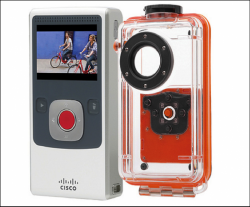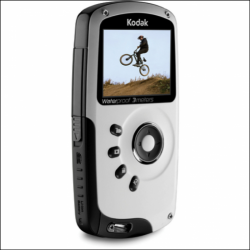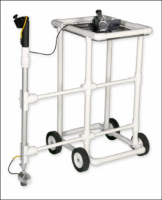Underwater Video Analysis
Which camera is right for you?
A swimming program that invests in an underwater video system has many options. Swimming stroke technique can be analyzed, allowing coaches and athletes to watch arm and leg position, body rotation and presence of air. Turns and starts can be analyzed, watching for streamlined body position and improvements to increase speed. Learn-to-swim programs benefit from allowing new swimmers to compare their strokes to video of accomplished swimmers. Below are a few options to consider when purchasing an underwater camera.
FLIP Ultra HD + Underwater Housing ($125)
Pros
- Small and easy to use
- Relatively cheap
- 720p HD 16x9 video
- USB 2.0 interface
- MPEG/H.264 files
- Interchangeable batteries
Cons
- Poor in low light
- Limited zoom
- Internal Memory only
- Small playback display
- Have to be in the water to use
- Limited slow-mo controls
- Cisco is discontinuing the Flip Product
Verdict
The Filp Ultra HD is good for collecting video underwater and sharing later, but not great for instant feedback due to its small display and limited slow motion controls. It’s relatively easy to transfer the files and email or post to YouTube.
Kodak Playsport ($120)
Pros
- Small and easy to use
- Relatively cheap
- 1080p HD 16x9 Video
- USB 2.0 interface
- .MOV files
- SD/SDHC memory card (32GB max)
- Waterproof, no need for separate case
Cons
- Poor in low light
- Limited zoom
- Small playback display
- Have to be in the water to use
- Limited slow-mo controls
- Rechargeable battery pack only
- Extra memory cards cost more
Verdict
Like the Flip Ultra HD, the Playsport is good for collecting video underwater and sharing later, but not great for instant feedback due to its small display and limited slow motion controls. The advantage over the Flip is that it is waterproof without a case and Kodak intends to support this model. It’s relatively easy to transfer the files and email or post to YouTube.
Total Performance Power Cam ($600)
Pros
- Adjustable pole camera
- Coach does not have to be in the water
- Good in low light
- 79-degree field of view
- Cart to walk next to swimmer
- Instant feedback via monitor, DVR or camcorder
- Built solely for underwater analysis of swimming
Cons
- SD video (420 TV Lines)
- Have to purchase recording devices to plug into
- 12-volt battery can be hard to come by if lost or damaged
- Not very portable
- Extra costs for viewing, playback and uploading
Verdict
This is a great choice for the serious coach that wants to capture a swimmer without getting in the water, while having many options on how and when it is presented to the swimmer. Unfortunately this equipment can be cost prohibitive for many programs and offers very little in portability and can be difficult to use. Additional equipment can almost double the initial investment. Total performance has many years of experience and support for customers.
Underwater Camera Company of America
Coach Cam ($529-$629)
Pros
- Adjustable pole camera
- Coach does not have to be in the water
- Good in low light
- Instant feedback via monitor, DVR or camcorder
- Built solely for underwater analysis of swimming
- Replaceable batteries
- External camcorder mount
- Sturdy construction
- Somewhat portable
Cons
- SD video (480 TV Lines)
- Have to purchase recording devices to plug into
- 12-volt battery is hard to come by
- Extra costs for viewing, playback and uploading
Verdict
Like the Power Cam, this is a great choice for the serious coach who wants to capture a swimmer without getting in the water, while having many options on how and when it is presented to the swimmer. Unfortunately this equipment can be cost prohibitive for many programs and offers very little in portability and can be difficult to use. Additional equipment can almost double the initial investment. This is great for groups of five to 10 people wishing to get instant feedback via a DVR or laptop computer. The Underwater Camera Company also has great support for those who need it. ASCA endorses this model of pole camera.
Conclusion
While these are just a few models, they are widely used in the swimming world today. It’s up to you as a coach to determine whether or not you will go with the hand-held cheaper HD cameras, or the pole cameras developed with stroke analysis in mind. Look around; there are a wide variety of options (and costs) to choose from. Unfortunately not all are great for swimming and many take up more time to operate than it’s worth.
I have had success with the Coach Cam with an Aiptek Action HD camcorder, as well as a Flip Ultra HD with underwater housing. I have seen many other coaches use security cameras and lipstick cameras from electronic stores or online specialty outlets, producing various levels of success. How you power the camera, capture the images and store the video for playback are important considerations when building your own system. Find something that fits your workflow, fits the needs of the team and is easy to use. This way you can spend more time coaching and less time adapting to the technology.
Categories:
- Technique and Training
















